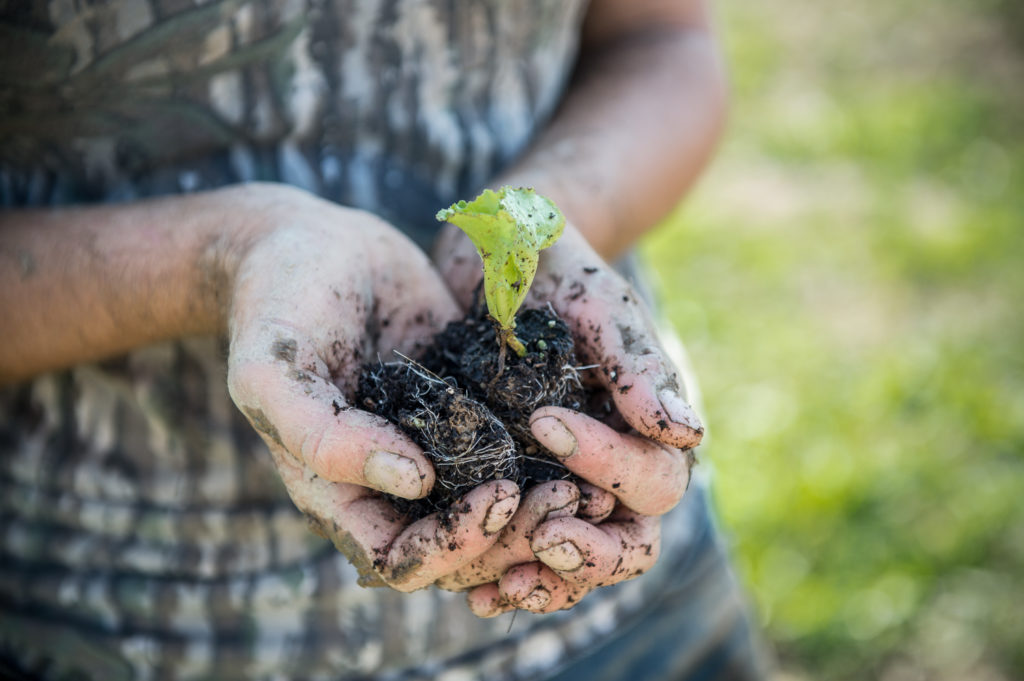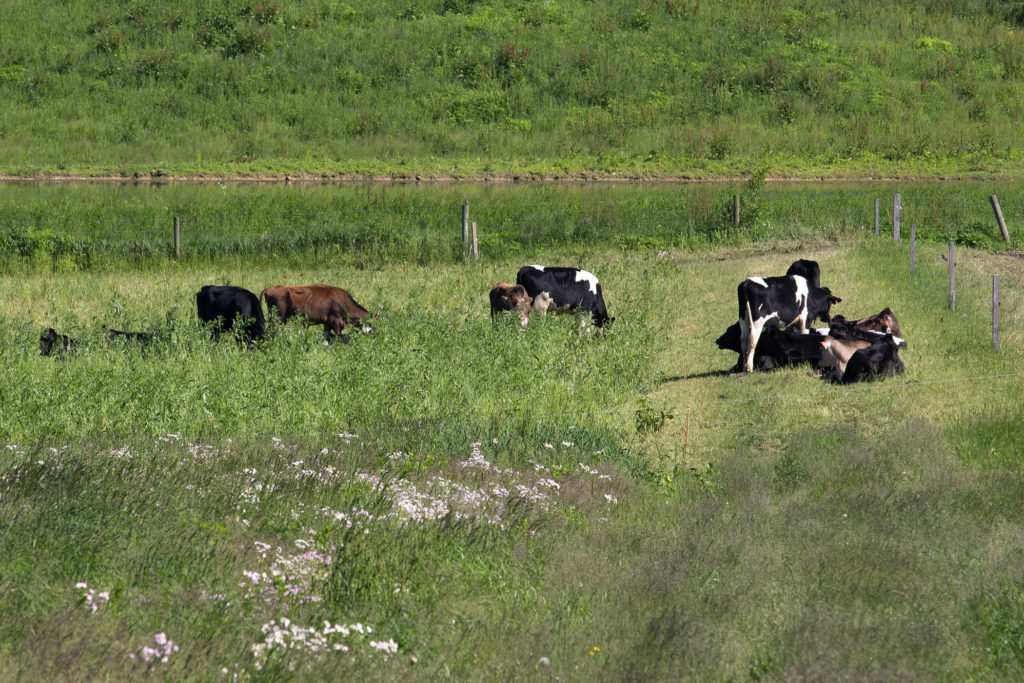A conversation with rangeland ecologist Richard Teague, PhD, analyzing the role that adaptive multi-paddock cattle grazing plays in sequestering carbon.
Rodale Institute’s updated climate change white paper, “Regenerative Agriculture and the Soil Carbon Solution,” will be published September 25th. To learn more, visit RodaleInstitute.org/Climate2020.
We’re in the process of updating Rodale Institute’s Regenerative Agriculture and the Soil Carbon Solution white paper and we wanted to talk to you about your influential work with cattle and rangeland soil carbon sequestration.
So to start, a question of semantics—there’s a lot of terms for management intensive grazing, you use adaptive multi-paddock or AMP, there’s mob grazing, high intensity rotational grazing, holistic grazing management, and now regenerative grazing. Are there practical differences between these systems?
There are small differences, but they’re all part of the same cadre in terms of a general way of doing things and the philosophy. Prior to starting our regenerative grazing studies in 1999, we worked with the NRCS who did all the soil mapping around the nation. We asked them to introduce us to farmers and ranchers who had the highest soil carbon levels. Without a single exception, they were all following Holistic Management, or a couple of variations around that. Our research has been following up on that ever since.
What are you finding in terms of how quickly soil can regenerate when you use the AMP grazing system?
It depends on your starting point. In the situation published from Georgia by Megan Machmuller and partners, they started with a farm that had been row cropped for a long time, which had resulted in degraded soil. They put it into permanent pasture and managed it using regenerative multi-paddock grazing with dairy cattle. Within three or four years they recorded substantial improvements. After five years they had enormous increases in soil carbon—up to eight tons of carbon per hectare per year. In areas where you can grow crops throughout the year, like in the southern half of the States, if you make sure there’s vegetative cover of the soil, a living root in the ground year-round and you practice regenerative grazing using multiple paddocks with adequate recovery, you will get extraordinarily rapid results. In our more arid areas in Texas, we find we need about 10 years to get substantive soil functional improvement. When we went up to Canada, we worked with people who had started 20 or 30 years ago, and they had moved ahead remarkably. Over those long time periods, the soil had been measured every second or third year, and in the best cases, within four or five years, there was a noticeable increase in soil carbon and surface water infiltration. In those northern areas, after 14 years now, there is still no decrease in the upward trajectory of the soil carbon.

But isn’t it generally accepted that soils have a carbon saturation point? That they can’t accrue carbon indefinitely?
These systems had been managed with regenerative grazing and had not been fertilized with inorganics or added biocides. These are critical elements for success—without addition of elements that kill off soil microbes, there will be increased biological diversity and activity below ground, which keeps the carbon stock going up. So, after 15 odd years, they’re up to 15% organic matter from about 1% to begin with, and the water infiltration rates continues to go up, from less than a half inch an hour to over ten inches an hour. And this is under much higher levels of cattle stocking, because they stock according to the amount of grass produced, and the biology of the system is managed to produce more grass.
Everybody refers to the 100 year old UK Rothamsted long term studies, which show that, over time, soil carbon increases then plateaus. However, a study of exactly how they managed those plots is revealing. They weren’t managing them to increase carbon, but to determine how soil carbon changed with different combinations of grazing and cutting hay relative to different cropping options. They grazed perennial forages, but if there was enough forage in the second half of the season to produce a hay crop, then they cut it for hay and took that off, then compared soil carbon dynamics with that grazing/hay system to plowing and growing annual crops and forages. They found the pasture management increased soil carbon for many years when they grazed it with sheep. At one point they stopped grazing the plots completely and started cutting it, and putting the residue back on the fields to try to complete the nutrient cycle. We know through a lot of science that when you cut hay, you are taking off carbon and taking off nutrients, you’re not improving the soil, you’re setting it back, so it is likely the hay cutting and removal negatively affected soil carbon levels.
In addition, we know from ecological training—versus agricultural training—that taking the grazing animal out of the system eliminates a key element of enhanced nutrient cycling. Ecological entomologists are finding that dung beetles play an enormous role as a key species. They not only dig holes and bury dung straightaway, but they foster a whole extra group of microbes that adds to the speed of nutrient cycling, thereby increasing soil carbon. So, the Rothamsted management took that key species and essential ecosystem function out and didn’t take it into account. It was soon after they made this management change that the soil carbon plateauing started. Where we have kept livestock on the land all the time under AMP management and not used fertilizers and pesticides, soil carbon is still going up after 15 years.
You underscore the importance of not having synthetic chemicals on the land, but if you start off with land that’s been conventionally managed, with fertilizer and pesticide regimes, is that going to set back the ability of the land to regenerate?
Well, for a start, probably one of the most beneficial organism groups for healthy soil are fungi, the AMF (arbuscular mycorrhizal fungi) and the saprotrophic fungi. The AMF form a network associated with roots. Their network reaches further into the soil improving soil structure and infiltration and accessing nutrients and water that would otherwise be unavailable to the plants. Along with the bacterial population, fungi build the correct structure of soil that allows greater water infiltration. All you have to do is take away the things that are decreasing the fungi and the right bacteria: tillage being one and chemicals being the other. Most tillage and chemical-based farming operations have diminished or destroyed the soil biota, but with management changes based on regenerative principles they can quickly recover. When you get rid of the elements suppressing key soil microbes and you start having a biodiverse mix of plants, you can get a response within a year or two in terms of soil regenerating.

The idea of planting biodiverse pasture seems impractical over vast rangelands. How does that work? Or does highly managed grazing itself eventually select for the certain perennials that will be more beneficial to fungi and other soil life that sequester carbon?
That’s a pertinent question. The people who practice regenerative grazing get rid of all the bad things and graze for a short period of time, allowing adequate plant recovery, which improves rooting depth, the fungal to bacterial ratio, soil texture and infiltration. As soil carbon increases in these systems, the fertility of the soil, the cation exchange capacity, increases because organic matter hangs on to so many more nutrients. Regenerative AMP grazing quickly improves soil biology and plant diversity, and the more productive, healthier plants naturally come back.
Another area of your team’s research is around beef production and greenhouse gases, so how do you respond to the popular trope that cattle are bad for the climate?
It’s both true and false. Let me start off with the truth. There is so much land that is poorly managed. People produce cattle on pastures that are generally heavily and continuously stocked and degraded as a consequence, and then they take the cattle and send them to feedlots for finishing. If you grow corn, or whatever else you’re feeding the cattle in feedlots, the conventional way, with tillage, inorganic fertilizers and biocides, you’re destroying soil. All of those things—poor rangeland management, feedlot systems, conventional feed production—have a huge carbon signature.
On the untrue portion: if you are managing like the regenerative grazing and cropping people we work with, you’ve taken poor soil and poor rangeland, and improved it through management, you’re not using chemicals, and you’re not finishing your cattle with feed that comes from conventional agriculture. If you’re doing it with crops managed the way Rodale does—producing crops with a negative carbon footprint—t then you’re putting carbon in the ground, the same as AMP grazing is putting carbon in the ground. If you combine those two things, regenerative grazing has enormous capacity to take carbon out of the air and put it in the ground while improving all the ecosystem services that come from healthy soil, particularly repairing the hydrological cycle to get more water in the soil, which improves everything.
Under the right management, cattle can make great things happen for the climate and for soil. Under poor management, most people know exactly what happens, and they say it’s cattle that have done this, but no, it’s the way the cattle have been managed that has done it. It’s good to point out those two choices we have—one is bad for the climate, yes, but the other is not bad at all, it’s entirely beneficial.
Learn more about Rodale Institute’s newest climate change research

